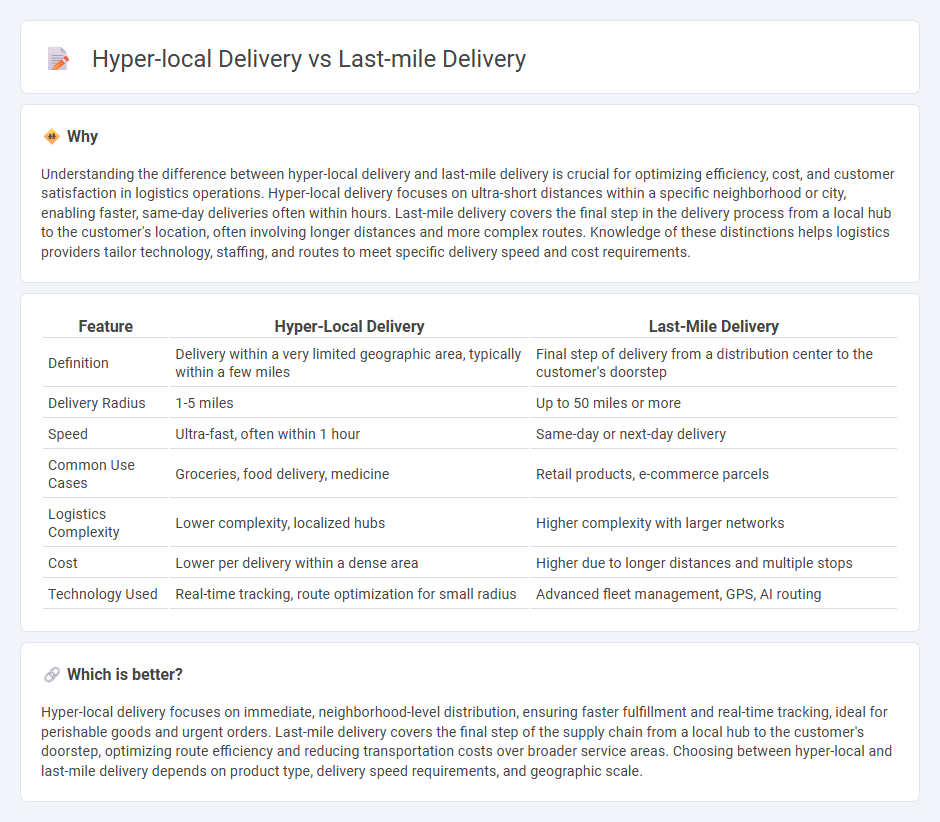
Hyper-local delivery focuses on fulfilling orders within a very limited geographic area, typically within a few miles, enabling faster delivery times and enhancing customer convenience. Last-mile delivery covers the final leg of the supply chain, transporting goods from a distribution hub to the customer's doorstep, often dealing with urban congestion and route optimization challenges. Explore how businesses leverage these strategies to improve efficiency and customer satisfaction in the evolving logistics landscape.
Why it is important
Understanding the difference between hyper-local delivery and last-mile delivery is crucial for optimizing efficiency, cost, and customer satisfaction in logistics operations. Hyper-local delivery focuses on ultra-short distances within a specific neighborhood or city, enabling faster, same-day deliveries often within hours. Last-mile delivery covers the final step in the delivery process from a local hub to the customer's location, often involving longer distances and more complex routes. Knowledge of these distinctions helps logistics providers tailor technology, staffing, and routes to meet specific delivery speed and cost requirements.
Comparison Table
| Feature | Hyper-Local Delivery | Last-Mile Delivery |
|---|---|---|
| Definition | Delivery within a very limited geographic area, typically within a few miles | Final step of delivery from a distribution center to the customer's doorstep |
| Delivery Radius | 1-5 miles | Up to 50 miles or more |
| Speed | Ultra-fast, often within 1 hour | Same-day or next-day delivery |
| Common Use Cases | Groceries, food delivery, medicine | Retail products, e-commerce parcels |
| Logistics Complexity | Lower complexity, localized hubs | Higher complexity with larger networks |
| Cost | Lower per delivery within a dense area | Higher due to longer distances and multiple stops |
| Technology Used | Real-time tracking, route optimization for small radius | Advanced fleet management, GPS, AI routing |
Which is better?
Hyper-local delivery focuses on immediate, neighborhood-level distribution, ensuring faster fulfillment and real-time tracking, ideal for perishable goods and urgent orders. Last-mile delivery covers the final step of the supply chain from a local hub to the customer's doorstep, optimizing route efficiency and reducing transportation costs over broader service areas. Choosing between hyper-local and last-mile delivery depends on product type, delivery speed requirements, and geographic scale.
Connection
Hyper-local delivery focuses on transporting goods within a small, defined geographic area, enabling faster shipments and real-time order fulfillment. Last-mile delivery represents the final step in the supply chain, where packages are delivered directly to the customer's doorstep, often within urban or densely populated regions. Both concepts optimize speed, efficiency, and customer satisfaction by minimizing transit distance and leveraging local distribution hubs or delivery personnel.
Key Terms
**Last-mile delivery:**
Last-mile delivery refers to the final step in the shipping process where a package is transported from a distribution center or warehouse to the customer's doorstep, often representing the most complex and costly segment of logistics. This delivery model emphasizes speed, efficiency, and accuracy in urban and suburban areas, leveraging technologies like route optimization and real-time tracking to enhance customer satisfaction. Explore more about how last-mile delivery innovations are transforming e-commerce and logistics efficiency.
Route Optimization
Last-mile delivery emphasizes efficient route optimization to ensure timely parcel drop-offs over longer distances, often spanning urban to suburban areas. Hyper-local delivery focuses on ultra-short routes within confined neighborhoods, optimizing paths for speed and frequent small-volume deliveries to meet immediate consumer demands. Explore advanced strategies and technologies to enhance route optimization for both delivery models.
Delivery Time Windows
Last-mile delivery typically covers a broader geographic area, offering time windows ranging from a few hours to an entire day, which suits standard e-commerce and retail logistics. Hyper-local delivery operates within a confined radius, often ensuring delivery within 30 minutes to 2 hours to meet urgent consumer demands in urban environments. Explore detailed comparisons to optimize your delivery strategy based on precise time window requirements.
Source and External Links
Last mile delivery: solutions for your business - Last-mile delivery is the final leg of moving goods from a local distribution center to the end consumer, prioritizing affordability, speed, and accuracy, and often includes multiple delivery options and new technologies like drones and autonomous robots.
How it Works, Benefits, & How to Fulfill with Last-Mile Carriers - Last-mile delivery focuses on transporting packages from fulfillment centers to customers' doors, with last-mile carriers aiming to optimize speed and cost, while tracking technologies improve customer satisfaction; however, last-mile delivery remains one of the costliest aspects of logistics.
Last-mile delivery: What it is and why it matters for retailers - Last-mile delivery is the most expensive and time-intensive step in shipping but is vital for customer satisfaction, enabling faster deliveries, increased convenience, and higher sales for retailers leveraging technology and efficient fulfillment logistics.
 dowidth.com
dowidth.com